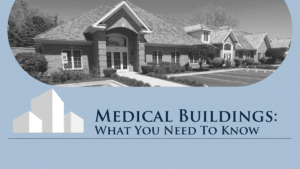The Future of Healthcare Real Estate: Building Location and Design Trends to Watch
The healthcare real estate market continues to prove its resiliency, most recently, in the wake of the COVID-19 pandemic. There was a brief pause in transaction activity during the depths of the pandemic, but the sector continued to chug along, with rent collections and occupancy generally right on track.
Medical office buildings, in particular, proved to be a bright spot for the industry. These properties became very high in demand and continue to be in demand today. Supported by an aging population, the need for medical office buildings is only expected to increase in the years to come.
Those considering investing in healthcare real estate will want to monitor specific building locations and design trends closely. The industry is rapidly evolving before our eyes, and these trends will influence where, when, and with whom people will want to invest.
Read on to learn more.
Related: What are The Best Ways to Invest in Healthcare Real Estate?
Subscribe to our commercial real estate newsletter.
Predicting the Pandemic’s Influence in the Future
The COVID-19 pandemic certainly impacted how healthcare services are delivered and where those services are delivered.
The pandemic forced many healthcare providers to put their expansion plans on hold, at least momentarily. Others have started to rethink how and where services are delivered entirely. For example, the use of makeshift facilities or temporary clinics emerged as a viable, short-term option for hospitals facing bed shortages. Meanwhile, many providers had to reassess how to staff their clinics due to a profound labor shortage.
According to one joint study by PwC and the Urban Land Institute, there will “likely be a massive shift” in traditionally designed spaces in healthcare facilities and other commercial property types due to the pandemic. For example, medical offices may develop more design flexibility. Standard patient rooms may be easily converted into ICUs in the future, especially in the wake of a significant public health emergency like a global pandemic.
That notwithstanding, the tide seems to be turning on healthcare providers’ expansion plans. After a momentary pause, and now that revenues are back on the rise, many clinicians are looking to grow and expand their operations– and need real estate to do so.
In short, medical office buildings have emerged as one of the critical darlings of the real estate market. These properties have proven to be exceptionally resilient in the wake of COVID. They provide essential services that cannot be put off indefinitely. Healthcare is not a discretionary need.
It’s no surprise, then, that investment in medical office buildings is once again on the rise. With so much pent-up demand, some have estimated that spending on healthcare construction projects will reach a staggering $45.8 billion in 2023.
Medical Offices Won’t be Impacted by Telehealth
COVID ushered in the widespread use of telehealth, at least compared to prior utilization rates. Whereas fewer than 1% of healthcare visits were held virtually pre-pandemic, the rate skyrocketed by 40% during the height of the pandemic. However, this trend has since slowed and even started to decline by all indications. According to the Commonwealth Fund, only 6% of healthcare visits were virtually conducted by September 2020.
Some specialties have barely been impacted by telehealth. Ophthalmology, orthopedics, surgery, dermatology, OB/GYN, urology, oncology, cardiology, and pediatrics are the specialties least likely to utilize telemedicine. The most significant outlier is behavioral health, which proved to use telemedicine successfully during the pandemic. Upwards of 40% of behavioral health appointments continue to be held virtually.
Therefore, even if the rate of telehealth visits remains marginally higher than it was pre-pandemic, few industry leaders expect it to have a dramatic impact on medical office properties. Moving forward, any replacement in in-person visits will likely occur among lower-acuity services. Medical offices oriented toward higher-acuity specialties may feel little to no impact from any rise in telemedicine.
These visits continue to be best held in person, where clinicians can meet face-to-face with their patients. This fact bodes well for medical office real estate investors, especially given that higher-acuity medical offices have historically boasted the most robust rent growth in the medical office market.
Related: Why Investors are Interested in Medical Office Buildings
Medical Office Building Location Trends to Watch
Medical office buildings are an often overlooked asset because many investors do not understand the nuances of the healthcare industry. However, those who learn about the sector will find that these properties make exceptional additions to any investor’s portfolio.
The key to successfully investing in medical office properties is to invest in well-located ones. Below, we look at some of the medical office building location trends that investors should be monitoring as we emerge from the COVID-19 crisis.
Bringing Healthcare Closer to Home
One trend that was already in the making pre-pandemic was the shift from providing healthcare on hospital campuses to moving that same care to off-campus medical office building (MOB) properties closer to where people live. This trend accelerated in the wake of COVID when people feared visiting urban areas and hospital settings where the risk of contracting the virus was arguably higher (especially if travel to these facilities required public transit).
Now, especially with so many individuals working remotely from home (and therefore, not traveling into urban areas with such frequency), there is a growing expectation for healthcare to be available closer to people’s homes.
One of the ways we’re seeing healthcare providers respond is by setting up shop in pharmacies, shopping malls, and even big-box retail locations like Walmart. These properties, which tend to be inherently well-located, provide greater convenience and ease of access than traditional hospital settings.
Move to Outpatient Facilities
Along those same lines, one of the hottest trends shaping healthcare real estate is the shift to providing medical care in outpatient facilities.
One of the reasons for this shift pertains to cost containment. Healthcare costs have been rising at dramatic rates. There’s growing pressure on the healthcare industry to drive down costs in response.
Healthcare providers are looking at many solutions.
One such solution has been to identify certain services that can be delivered off-campus. This could involve care made available at outpatient facilities, or in some cases, through third-party home health companies that provide care at patients’ homes.
The benefit of outpatient facilities is that they are often less expensive to construct and operate than traditional hospitals. However, building new MOB properties is still another cost hospital systems incur (and arguably, the construction of said facilities does not contain costs). In some cases, hospitals will look to dispose of and monetize or otherwise consolidate their more costly urban campuses to help offset the costs of new outpatient facilities.
Outpatient facilities are also growing in popularity among non-system healthcare providers. Building networks of small, branded facilities that offer specific services– ranging from visual to dental services, physical therapy to cosmetic care– is becoming ever more profound, a trend expected to continue for the foreseeable future.
Whether you’re a new player to the investment world or a long-standing investment professional with the best portfolio in the business, selecting a quality healthcare real estate or medical office building investment can be a tricky decision. Consider reaching out to our team of experts at Alliance today to learn about everything we can do to help.
The Future of Standalone Urgent Care Clinics
During the past decade, there has been a dramatic increase in standalone urgent care clinics (or “Doc in a Box” facilities). These immediate-care clinics offer various services, from stitches and x-rays to viral testing and more. Large amounts of these facilities are privately owned and occupied by regional chains. Their business model is simple:
- Treat as many people with minor injuries or symptoms as possible.
- Do it as quickly as possible.
- Submit for health insurance reimbursements accordingly.
These standalone clinics can be as small as 1,500 square feet and do not require as extensive equipment (e.g., CTs and MRIs) that are otherwise found in a more traditional hospital or MOB facilities. Because of this, operators can deliver services at a lower cost for identical reimbursable amounts.
The outlook for these properties remains a mixed bag.
Some industry experts feel that these facilities have been overbuilt and expect their proliferation to slow. To that end: there are an estimated 10,400 urgent care clinics operating today, a 63% increase from just seven years ago.
Meanwhile, other healthcare real estate industry experts anticipate private equity investment in these properties to fuel their ongoing expansion. Private equity investors are particularly drawn to the robust economics of these facilities. Those with solid management may still be well-positioned to thrive in an otherwise overbuilt environment.
Consolidation of Healthcare Practices
Mergers and acquisitions (M&A) activity among healthcare providers is rising, undoubtedly impacting medical real estate moving forward. According to the Physicians Advocacy Institute, between 2019 and 2020, U.S. hospital systems acquired an estimated 3,200 independent physician practices– an 8% gain in hospital-owned practices.
As these formerly independent practices are absorbed into larger healthcare systems, what happens to their real estate remains to be seen. In some cases, the hospital system may also elect to purchase the real estate, re-branding the facility accordingly. In other cases, the practices may be brought in-house or to an existing hospital campus, which would allow these properties to be purchased by other MOB investors willing to re-tenant the property to other healthcare clinicians.
Related: The Ultimate Guide to Investing in Medical Office Buildings
Healthcare Real Estate Design Trends to Watch
Anyone considering investing in new medical office building construction, or a MOB project about to undergo a significant value-add repositioning, will want to be keenly attuned to the following healthcare real estate design trends. These design trends will all impact the leaseability and, ultimately, the value of medical office buildings.
Improved Signage and Wayfinding
In general, the U.S. population is rapidly aging, and as people age, they are in greater need of medical services. This fact means that medical office buildings should be designed for both the young and the elderly, but specifically, designed with signage and wayfinding that makes healthcare facilities easy to navigate.
Wayfinding is a term commonly used to describe the tools used to help individuals navigate a space. This can include flooring designs, patterns, and colors that serve as a map to help guide people through large, unfamiliar areas. For example, a medical office building might mix-and-match wood and tile flooring to create a pattern that people can quickly identify and follow while walking.
Wayfinding should be augmented by well-lit, clearly visible signs that point people where they need to go.
More Comfortable Waiting Areas
Healthcare providers face increased competition with the growth of private practices and new suburban facilities. Therefore, providing an exceptional patient experience is more important than ever for patient attraction and retention.
One way to improve the patient experience is by designing more comfortable waiting areas. This includes a combination of fixed and flexible furniture, including both soft and hard seating, as some patients will be more pleased with one versus the other. Patient waiting areas should be equipped with modern technology and amenities, such as USB outlets for charging personal devices. Soft lighting and music can also be used to improve the waiting room experience. In some instances, providing light refreshments might also be appropriate depending on the demographic and patient groups being served.
“Greening” of Medical Office Buildings
Patients are increasingly aware of how buildings are designed (or not) to promote a more resilient and sustainable future. In turn, many healthcare real estate investors are prioritizing sustainability at their medical office properties.
Sustainable features can come in many shapes, sizes and forms. For example, a newly constructed facility might employ more extensive systems, like rooftop or parking lot solar canopies. Owners may introduce more heavily landscaped areas with walking paths and seating designed to encourage and facilitate patient use and wellness in a campus-like MOB setting.
At MOB properties under renovation, the improvements may be more subtle, such as replacing traditional lighting with LED fixtures, using low-VOC paints, and waste-diversion efforts.
There are benefits for owners and tenants alike. Properties that successfully reduce their energy emissions, waste, and water target will save money– and these cost-savings can be passed on to the respective parties depending on how lease agreements are structured. They can also be a helpful write-off for investors come tax time.
The” greening” of medical office buildings is a trend to watch closely. As these investments are made, they will increase property values and make them more attractive to well-heeled investors looking to add MOB properties to their portfolios.
Final Thoughts and Considerations
Although a niche sector, healthcare real estate is increasingly on the radar of investors of all kinds. A field once dominated by institutional investors, real estate investment trusts (REITs), and legacy, mom-and-pop owners, have since had the door blown open as demand for medical office property has skyrocketed.
Given the future outlook for healthcare real estate, there’s no better time to begin investing.
Are you currently interested in expanding or diversifying your investment portfolio by acquiring a selection of quality healthcare real estate or medical office buildings? Our specialized team of investment experts at Alliance is dedicated to helping you find the best properties to meet your needs and help you build your wealth.
POSTED BY
Ben Reinberg
Founder & CEO | Alliance Group Companies

Ben Reinberg is Alliance Group Companies' founder and CEO.
Since 1995, Alliance Consolidated Group has acquired and invested in medical properties with net leases between $3 and $25 million across the United States. With decades of commercial real estate experience, we take pride in committing to meeting the goals of our Sellers, as we consistently and seamlessly adhere to successful closings.



